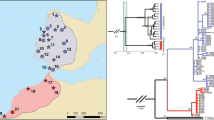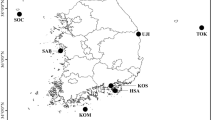Abstract
Blue mussels representing two nominal species (Mytilus trossulus Gould, 1850 and Mytilus galloprovincialis Lamarck, 1819 were collected from 28 intertidal locations along the Pacific coast of the USA in 1990–1991 (total N=1255) and examined for variation at 15 allozyme loci. Twelve samples, mostly from a region of suspected hybridization, were analyzed for variation in seven shell characters. Principal-components analysis of allozyme data revealed three groups based on first principal-component scores, which were identified as M. trossulus, M. galloprovincialis, and hybrids. Canonical discriminant analysis of shell characters was less successful in separating mussels into discrete groups. Each location was characterized for four environmental variables: (1) temperature, (2) salinity, (3) tidal height and (4) degree of exposure to wave action, which were then used as independent variables in a series of multiple-regression analyses, with the proportions of the two species as dependent variables. Temperature and salinity had significant (P<0.05) effects on the macrogeographic distribution of the two species, whereas the effects of height in the tidal zone and degree of wave exposure were not statistically significant. Salinity was found to have a greater influence than temperature on the microgeographic distribution of the two species. M. trossulus was more abundant at locations with lower temperatures and greater salinity variation than M. galloprovincialis. The two species appear to be ecologically distinct, and their genetic integrity is at least partly the result of environmental heterogeneity.
Similar content being viewed by others
Literature cited
Alston, R. E., Turner, B. L. (1963). Natural hybridization among four species of Baptisia (Leguminosae). Am. J. Bot. 50: 159–173
Barrett, E. M. (1963). The California oyster industry. Calif. Fish Game Fish Bull. 123: 1–103
Beaumont, A. R., Seed, R., Garcia-Martinez, P. (1989). Electrophoretic and morphometric criteria for the identification of the mussels Mytilus edulis and M. galloprovincialis. Proc. 23rd Eur. mar. Biol. Symp. 1: 251–258 [Ryland, J. S., Tyler, P. A. (eds.) Olsen & Olsen, Fredensborg, Denmark]
Briggs, B. G. (1962). Interspecific hybridization in the Rununculus lappaceus group. Evolution 16: 372–390
Briggs, J. C. (1974). Marine zoogeography. McGraw-Hill, New York, N.Y.
Campton, D. E. (1987). Natural hybridization and introgression in fishes: methods of detection and genetic interpretations. In: Ryman, N., Utter, F. (eds.) Population genetics and fishery management. University of Washington Press, Seattle, Washington, p. 161–192
Churgin, J. (1974). Temperature, salinity, oxygen, and phosphate in waters off United States. United States Department of Commerce, National Oceanic and Atmospheric Administration Environmental Data Service, National Oceanographic Data Center, Washington, D.C.
Curtis, F. (1966). Molluscan species from early southern California archeological sites. Bull. Sth. Calif. Acad. Sci. 65: 107–127
Dedini, L. A., Schemel, L. E., Turnbull, M. A. (1981). Salinity and temperature measurements in San Francisco Bay waters, 1980. United States Geological Survey, Menlo Park, California (Open-File Rep. No. 82-125)
Gardner, J. P. A. (1992). Mytilus galloprovincialis (Lmk.) (Bivalvia, Mollusca): the taxonomic status of the Mediterranean mussel. Ophelia 35: 219–243
Garthwaite, R. (1986). The genetics of California populations of Geukensia demissa (Dillwyn) (Mollusca): further evidence on the selective importance of leucine aminopeptidase variation in salinity acclimation. Biol. J. Linn. Soc. 28: 343–358
Gartside, D. F. (1980). Analysis of a hybrid zone between chorus frogs of the Pseudoacris nigrita complex in the southern United States. Copeia 1980: 56–66
Gosling, E. M. (1984). The systematic status of Mytilus galloprovincialis in western Europe: a review. Malacologia 25: 551–568
Harger, J. R. (1970). The effect of species composition on the survival of mixed populations of the sea mussels Mytilus californianus and Mytilus edulis. Veliger 13: 147–152
Harrison, R. G., Rand, D. M. (1989). Mosaic hybrid zones and the nature of species boundaries. In: Otte, D., Endler, J. A. (eds.) Speciation and its consequences. Sinauer, Sunderland, Massachusetts, p. 111–133
Haydock, C. I. (1964). An experimental study to control oyster drills in Tomales Bay California. Calif. Fish Game 50: 11–28
Howard, D. J. (1986). A zone of overlap and hybridization between two ground cricket species. Evolution 40: 34–43
Johannesson, K., Kautsky, N., Tedengren, M. (1990). Genotypic and phenotypic differences between Baltic and North Sea populations of Mytilus edulis evaluated through reciprocal transplantations. II. Genetic variation. Mar. Ecol. Prog. Ser. 59: 211–219
Koehn, R. K. (1991). The genetics and taxonomy of species in the genus Mytilus. Aquaculture, Amsterdam 94: 125–145
Koehn, R. K., Hall, J. G., Innes, D. J., Zera, A. J. (1984). Genetic differentiation of Mytilus edulis in eastern North America. Mar. Biol. 79: 117–126
Lewis, J. R., Seed, R. (1969). Morphological variations in Mytilus from southwest England in relation to the occurrence of M. galloprovincialis Lamarck. Cah. Biol. mar. 10: 231–253
Liu, L. L., Foltz, D. W., Stickle, W. B. (1991). Genetic population structure of the southern oyster drill Stramonita (=Thais) haemastoma. Mar. Biol. 111: 71–79
Machell, J. R., DeMartini, J. D. (1971). An annual reproductive cycle of the gaper clam Tresus capax (Gould) in South Humboldt Bay, California. Calif. Fish Game 57: 274–282
Malachowski, M. (1988). The reproductive cycle of the rock scallop Hinnites giganteus (Grey) in Humboldt Bay, California. J. Shellfish Res. 7: 341–348
McDonald, J. H., Koehn, R. K. (1988). The mussels Mytilus galloprovincialis and M. trossulus on the Pacific coast of North America. Mar. Biol. 99: 111–118
McDonald, J. H., Seed, R., Koehn, R. K. (1991). Allozymes and morphometric characters of three species of Mytilus in the Northern and Southern Hemispheres. Mar. Biol. 111: 323–333
Murphy, R. W., Sites, J. W., Buth, D. G., Haufler, C. H. (1990). Proteins I: Isozyme electrophoresis. In: Hillis, D. M., Moritz, C. (eds.) Molecular systematics. Sinauer, Sunderland, Massachusetts, p. 45–126
Nybakken, J., Caillet, G., Broenkow, W. (1977). Ecological and hydrographic studies of Elkhorn Slough, Moss Landing Harbor and nearshore waters. Moss Landing Marine Laboratories, Moss Landing, California
Richardson, B. J., Baverstock, P. R., Adams, M. (1986). Allozyme electrophoresis: a handbook for animal systematics and population studies. Academic Press, Orlando, Florida
Sarver, S. K. (1989). Genetic differentiation of the mussel Mytilus edulis along the coast of California and in Humboldt Bay. M. S. thesis. Humboldt State University, Arcata, California
Sarver, S. K. (1993). Genetic population structure of a species complex of blue mussels (Mytilus spp.) Ph. D. dissertation. Louisiana State University, Baton Rouge, Louisiana
Sarver, S. K., Landrum, M. C., Foltz, D. W. (1992). Genetics and taxonomy of ribbed mussels (Geukensia spp.). Mar. Biol. 113: 385–390
Sarver, S. K., Loudenslager, E. J. (1991). The genetics of California populations of the blue mussel: further evidence for the existence of electrophoretically distinguishable species or subspecies. Biochem. Syst. Ecol. 19: 183–188
SAS Institute, Inc. (1985). SAS user's guide: statistics. Version 5 edn. SAS Institute, Inc., Cary, North Carolina
Seed, R. (1968). Factors influencing shell shape in the mussel Mytilus edulis. J. mar. biol. Ass. U.K. 48: 561–584
Seed, R. (1972). Morphological variations in Mytilus from the French coasts in relation to the occurrence and distribution of M. galloprovincialis Lamarck. Cah. Biol. mar. 13: 357–384
Seed, R. (1974). Morphological variations in Mytilus from the Irish coasts in relation to the occurrence and distribution of M. galloprovincialis Lamarck. Cah. Biol. mar. 15: 1–25
Seed, R. (1976). Ecology. In: Bayne, B. L. (ed.) Marine mussels: their ecology and physiology. International Biological Programme. 10. Cambridge University Press, Cambridge, England, p. 13–65
Seed, R. (1992). Systematics, evolution and distribution of mussels belonging to the genus Mytilus: an overview. Am. malac. Bull. 9: 123–137
Shaklee, J. B., Allendorf, F. W., Morizot, D. C., Whitt, G. S. (1990). Gene nomenclature for protein-coding loci in fish. Trans. Am. Fish. Soc. 119: 2–15
Shaw, E., Allen, J., Stone, R. (1974). Notes on the collection of shiner perch Cymatogaster aggregata in Bodega Bay, California. Calif. Fish Game 60: 15–22
Skibinski, D. O. F., Beardmore, J. A. (1979). A genetic study of intergradation between Mytilus edulis and M. galloprovincialis. Experientia 35: 1442–1444
Soot-Ryen, T. (1955). A report on the family Mytilidae (Pelecypoda). Allan Hancock Pacif. Exped. 20: 1–175
Tison, J. C. (1967). Surface water temperature and density: Pacific Coast North and South America and Pacific Ocean Islands. Publs U.S. Cst geod. Surv. 31–3: 1–85
Väinölä, R., Hvilsom, M. M. (1991). Genetic divergence and a hybrid zone between Baltic and North Sea Mytilus populations (Mytilidae: Mollusca). Biol. J. Linn. Soc. 43: 127–148
Varvio, S.-L., Koehn, R. K., Väinölä, R. (1988). Evolutionary genetics of the Mytilus edulis complex in the North Atlantic region. Mar. Biol. 98: 51–60
Weir, B. S., Cockerham, C. C. (1984). Estimating F-statistics for the analysis of population structure. Evolution 38: 1358–1370
Wiley, E. O. (1981). Phylogenetics: the theory and practice of phylogenetic systematics. Wiley, New York, N.Y.
Woodruff, D. S., Staub, K. C., Upatham, E. S., Viyanant, V., Yuan, H.-C. (1988). Genetic variation in Oncomelania hupensis: Schistosoma japonicum transmitting snails in China and the Philippines are distinct species. Malacologia 29: 347–361
Author information
Authors and Affiliations
Additional information
Communicated by N. H. Marcus, Tallahassee
Rights and permissions
About this article
Cite this article
Sarver, S.K., Foltz, D.W. Genetic population structure of a species' complex of blue mussels (Mytilus spp.). Marine Biology 117, 105–112 (1993). https://doi.org/10.1007/BF00346431
Received:
Accepted:
Issue Date:
DOI: https://doi.org/10.1007/BF00346431




